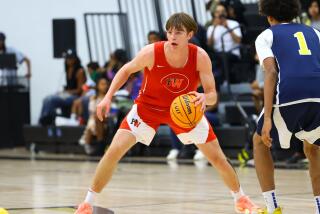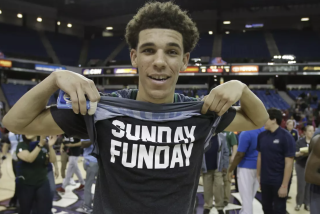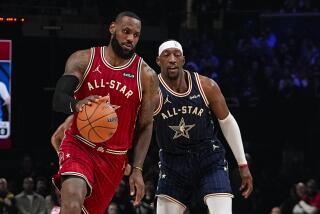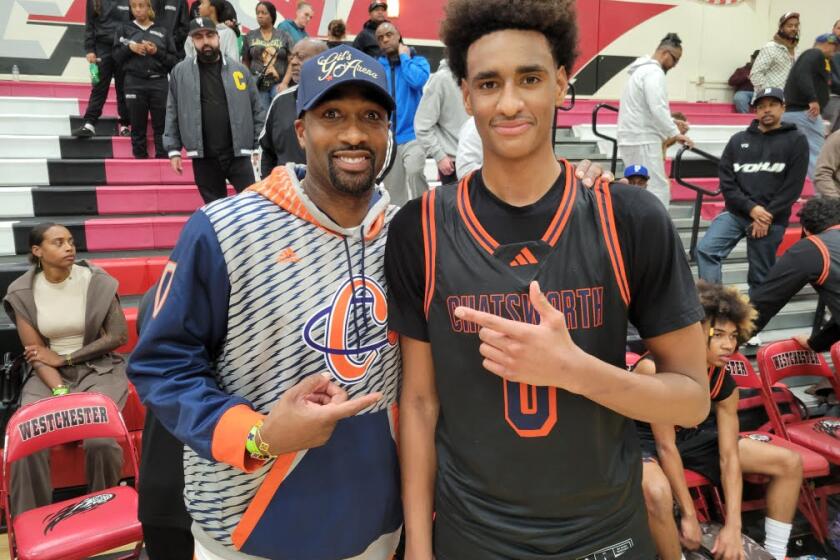A Long Way to the NBA
Inside a Maywood gymnasium, two basketball teams competed before mostly empty stands.
It would have been easy to mistake the game for a local league contest or even a friendly scrimmage if not for the television camera crews and massive banners advertising Chinese telecommunications and furniture companies.
Not many people in Maywood cared who won or lost the game. But 5,000 miles away, about 15 million Chinese tuned in, as they do several times a week, to see the game on CCTV5 -- the Chinese ESPN. They were watching Beijing Aoshen Olympian, a professional basketball club that had found an unlikely home in the American Basketball Assn., a league of NBA has-beens, wannabes and might-have-beens.
Though some of the teamâs 12 Chinese players are routinely recognized on the streets of Beijing, here they live anonymously in modest dorm rooms at the University of the West, a Buddhist-founded campus in Rosemead. The teamâs star player, the 6-foot-9 Sun Yue, draws only curious looks when he strolls through L.A.-area malls shopping for sneakers.
The teamâs owner, Winston Lee, a wealthy developer and music promoter, decided to send his players to the United States to face tougher talent. He also was fairly sure that Chinese companies would pay to see the games broadcast to China because basketball has become one of the nationâs hottest sports, fed by national pride in Yao Ming, the star center for the NBAâs Houston Rockets. Today, the game is âas big as ping-pong,â said Zhang Changhong, Aoshenâs general manager.
There is no confusing the ABA with the NBA. This is a sometimes ragtag league where the team salary cap is $120,000 and games are occasionally canceled when teams fail to pay their players on time. Aoshen paid $10,000 to join the ABA. Most team owners get by with revenue from ticket sales and modest sponsorships and merchandising.
For Sun and his teammates, the league is their chance to follow in Yaoâs footsteps. But in Maywood and in other gyms throughout the West, Chinese aspirations have met American reality.
Competing almost exclusively against American players, Aoshen had to change from the conservative Chinese approach to a style that demands athleticism, intensity and flair.
As a team, their challenge was to survive a five-month season, weather the cultural shocks and maybe even make the playoffs.
âIn American basketball, everyone has confidence,â said Sun, 20, after a recent game in which his coach chastised him for not being more aggressive. âBasketball is much better here.â
*
At first glance, Aoshen looks intimidating. They are one of the tallest teams in the league, with one player reaching 7 feet 1.
âI was standing behind one of them and I thought I was looking at Yao Ming from behind,â said Rob Ridnour, coach of the Washington state-based Bellingham Slam, at a game in Maywood late last year.
Aoshen began the season convincingly, winning their first six games. But then word spread throughout the league that the Beijing team could be pressured into mistakes.
Six minutes into the game against Bellingham, Sun had been stripped of the ball three times.
Aoshen Coach LaShun McDaniel, an American who has coached in South America, Asia and Europe, shouted at his players to play with more ferocity.
âKick his [rear]!â McDaniel said.
Aoshen would eventually win, 112-105, after some sharp passes by Sun and a deluge of three-point shots from two of the teamâs American players.
It was an aggressive style that McDaniel had been trying to instill: fast, loose and fluid.
âEverything about them was slow, half-court basketball,â McDaniel said, referring to the first time he met the Chinese players. âI wanted a more up-tempo game. They didnât know basketball could be that fun. I saw 24-year-old men turn into 14-year-old boys.â
The teamâs stoicism was more likely a cultural byproduct than an attitude problem. In China, the players were taught that emotion implied weakness or a lack of concentration.
So, although their opponents burst on the court with NBA swagger and attitude, the Chinese players were stone-faced, giving no hint whether they thought they would win or lose.
One of those was center Huang Hai Bei, who along with Sun is considered one of the teamâs best prospects. After playing in the United States, he realized that he was being outplayed under the basket.
âI need to change,â said Huang, 23. âI need to play more strong.â
The job of helping Huang, Sun and the other players adjust fell not only on McDaniel, but on Fred Vinson, one of the teamâs three American players.
During games, Vinson paced the court slapping his Chinese teammatesâ chests and shouting âLetâs go!â To him, their timid demeanor reflected timid play, resulting in stripped balls, anxious shooting and mediocre blocking.
âThey are always calm,â said Vinson, 35, who played briefly in the NBA in the 1994-95 and 1999-2000 seasons. âIn the pros, you need to be consistent every night. They donât understand you have to play hard all the time. Thereâs no cruising. Otherwise someone will score 10 points on you all of a sudden.â
Vinson believes that a big part of assisting the Chinese players to succeed in America is to help them relax and think more spontaneously. He teaches them slang and sayings like, âWhatâs up?â and âJust chillinâ.â
He even sticks up for them when opponents try to intimidate them -- hoping his in-your-face style will rub off.
âThis dude was talking trash to [Sun], using slang and everything,â said Vinson, recalling a recent game. âI said to him, âHey money, you know that he donât understand nothing youâre saying.â Come on, these guys are still learning English and this guy is using slang? [Sun] kept coming at him the same way. Heâs not intimidated because he doesnât understand.â
Of all the Chinese players, Sun, nicknamed Q or Q-Tip, has most embraced American culture. His favorite musician is R&B; superstar Usher. He studies DVDs of street-ball competitions in New York.
Off the court, the rail-thin, 205-pound Sun usually wears a ribbed tank top, baggy jeans, a faux-diamond stud earring, an oversized leather jacket and whatever sneakers pique his interest that day.
âLook at how heâs dressed,â Vinson said recently inside Sunâs dorm room. âHeâs got flavor.â
But on the court, Sun said, he still struggles with the clash of cultures.
âI have a lot to prove,â Sun said. Vinson âtells me not to care what [opponents] say. He tells me to just beat them. Iâve been told Chinese people canât jump. Then why did I just block that guy eight times?â
Yao showed Sun that Chinese players could compete successfully in the NBA. But for all the talk about aggressiveness, Sun thinks that Yaoâs success is due more to his basketball intelligence. âHe has to play smart,â Sun said. âMost Chinese players donât have aggression. They donât have the strongest bodies. I will learn to play smart, not angry. Otherwise people will press you and steal the ball. A guard canât be angry. You must control everything.â
Despite the cultural barriers, scouts consider Sun a legitimate NBA prospect.
Jonathan Givony, president of draftexpress.com, a website that covers NBA prospects worldwide, said Sun has drawn a lot of attention because he is a deft point guard who is unusually tall for his position.
Sun realized that coming to the United States might be one of his best chances at making the NBA. But it also meant leaving his family. When Sun played in Beijing, his family was only a few hours drive away.
âI missed home a lot,â Sun said. âItâs better now. I call home after every game. They say, âWhat did you do? How many points? Rebounds? Turnovers? Seven? Thatâs too much. You have to control yourself.â â
*
After four months of playing American basketball, the players had made strides. But the demands of adapting to a different style of play and a grueling schedule had begun to wear on them. Their shortcomings were on display in a January game between Aoshen and the San Francisco Pilots in Maywood.
The visitors brutalized their hosts, building a 17-point lead by halftime. The Pilots exposed Sunâs weak shooting and his overreliance on his left-handed dribble. Huangâs inability for most of the game to be a force under the basket and an all-round poor team effort allowed San Francisco to take shot after shot against virtually no defensive pressure.
It was clear to the fans what the problem was.
âTheyâre just not strong enough,â said Jay Zhou, 26, who was watching the game with friends after reading about the Maywood games in a Chinese newspaper. âThey donât show any feeling.â
That game was part of a losing streak against such teams as the SoCal Legends, Tijuana Dragons, Orange County Buzz and Inglewood Cobras.
Through the beginning of February, Aoshen lost 10 of 13 games and their record dropped to 11-13. Then Sun and Huang were called to Florida to represent Aoshen in the ABA All-Star game on Valentineâs Day. It turned out to be another humbling experience. Sun and Huang were given only a few minutes of playing time.
But the game signaled a turnaround. Though the players denied it, McDaniel said, that lack of playing time left them feeling shunned and determined to prove that they belonged among the leagueâs elite players.
Sun âis being more aggressive. Heâs going to the basket. Heâs not breaking under the pressure,â the coach said. âHeâs smiling now because heâs able to dribble left and right.â
The team rattled off eight wins in a row after the All-Star break. Sun continued to tally impressive assist, steal and point totals. He committed only one turnover in a recent game against Fresno. Huang turned into an offensive force with two 30-plus-point performances and his first 40-point effort.
âThe All-Star game made me feel like I had to play with more heart,â Sun said. âThe players there may not have been that good, but they always played hard.â
Last Friday they were only one win away from a league playoff berth in Rochester, N.Y. They needed to beat the SoCal Legends, a team they had lost their first three meetings to but had defeated twice in a row since the All-Star break.
Much of the game was discouraging, with Aoshen playing like the bad old days. Sun could not sink his shots, Huang could not penetrate inside, and Vinson could not get good looks at the basket. They were down 12 by points entering the fourth quarter.
Then Sun awoke in the final period. He started the comeback with a pair of slam dunks. Vinson added a three-pointer and Huang sank a two-pointer to shrink the Legendsâ lead to 93-91. With 38 seconds remaining, Sun dribbled the ball through the arc, split three defenders and laid the ball in to tie the score at 95.
The Legends answered with two points to regain the lead.
Aoshen had one last chance, but their final shot bounced off the edge of the backboard.
When the buzzer sounded, Frank Sinatraâs âNew York, New Yorkâ came over the sound system. Sun slumped down, his hands on his knees. Huang stared aimlessly into the air, unable to will himself off the court until several minutes later.
âWe played better than anyone thought we would,â McDaniel said.
Left to ponder whether his team had learned how to play in the United States, he said, âI really hope so. I really hope so.â
More to Read
Go beyond the scoreboard
Get the latest on L.A.'s teams in the daily Sports Report newsletter.
You may occasionally receive promotional content from the Los Angeles Times.











